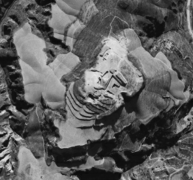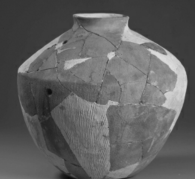 |
 |
CHINA DAILY
An aerial photo of the excavation.
|
CHINA DAILY
A pot excavated from the remains. |
Archaeologists have made important discoveries in the excavation of an ancient building dating back to the late Shang Dynasty (c.16th century-11th century BC).
The Shaanxi Provincial Institute of Archaeology recently announced the discovery, revealing that the remains of the 4,200-square-meter building on a hilltop in Northwest China's Shaanxi province is the largest Shang Dynasty ritual site on the Loess Plateau, and the second largest found, only bested by the Yinxu Ruins in Anyang, Henan province in Central China.
Located in Xinzhuang village, Qingjian county on the west bank of the Yellow River, the late Shang site lies in the middle of an area of more than 100,000 sq m in which there were other small building ruins, tombs and production traces made by ancient people.
Zhong Jianrong, head of the archaeological team, says the excavation started toward the end of 2012, when the ruins were the target of illegal excavations.
More than 100 artifacts made of clay, bone, copper, wood and stone have been unearthed, including the earliest wooden floors ever found on the plateau.
Zhong says the most important discovery is the 4,200-sq-m structure consisting of a main building surrounded by two levels of corridors. The head of the archaeological team says the ruins of the main building run about 35 meters from east to west in length and 22 meters from south to north in width, while its foundation runs as deep as 2.7 meters.
The main building is believed to have its gate opened on its east wall, as the ruins on its east wall show a 1.8-meter wide channel, which is believed to be the doorway. Inside the doorway is a stone slate, which remains intact and experts believe is the decoration doorway stone.
The two-level corridors were circular around the main building, but its west section was destroyed by unknown cause. They run parallel, apart from each other 10 meters horizontally and 4 meters vertically.
"We found some postholes between the two corridors, which mean there might be some buildings between the corridors," Zhong says.
Archaeologists also unearthed more than 5,000 pieces of pottery fragments from the building ruins, and repaired and fixed 20 pottery containers.
Though the relics features a construction and ornamental style consistent with those built in the late period of the Shang Dynasty, Zhong says, "It's unique in its structure and scale."
The archaeologist stipulates that the ruins must have served as a ritual place, rather than residence of the common folks, which they hope to prove with further excavations of surrounding ruins.
We recommend:
